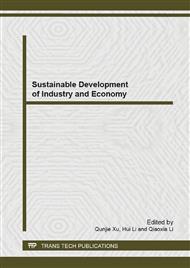p.1080
p.1085
p.1091
p.1096
p.1106
p.1112
p.1117
p.1121
p.1128
Study on Rural Labor Transfer in Resource-Abundant Region - A Case Study on Four Counties in the Northern Shaanxi
Abstract:
Owning to the restrictions from the lack of professional skills and objective factors, rural labor force in resource-abundant region mainly transfers to the local industries with low demands on employment, such as the energy industry and service industry. According to the empirical study, the transfer of rural labor force in resource-abundant region is mainly influenced by such factors as the wage income, transfer cost, educational level and professional skill, and in order to solve the problems concerning rural labor transfer, it can promote the labor force transfer properly through perfecting the labor market, establishing comprehensive community, strengthening the vocational-technical education and developing new industries.
Info:
Periodical:
Pages:
1106-1111
Citation:
Online since:
December 2013
Authors:
Keywords:
Price:
Сopyright:
© 2014 Trans Tech Publications Ltd. All Rights Reserved
Share:
Citation:


